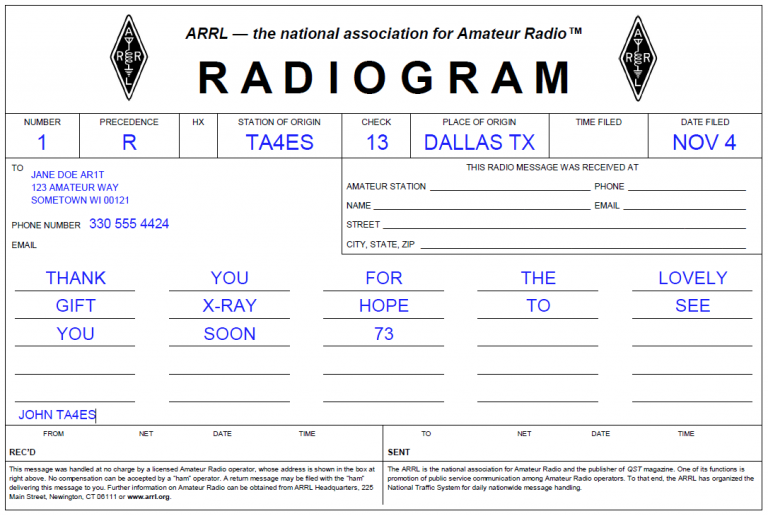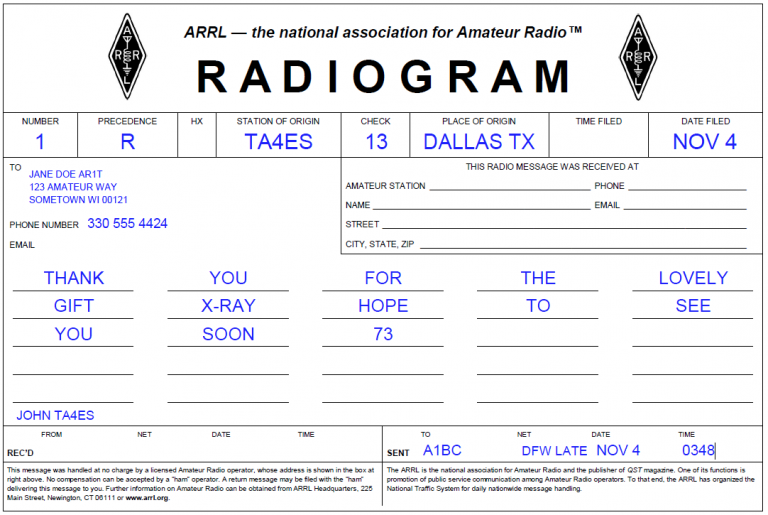To send your first radiogram you would check in to a traffic net and when they ask you if you have any traffic (a.k.a. any messages or radiograms) you would say, “I have one going to Wisconsin.” The net control station will note your traffic and if there is someone available to help move your traffic towards Wisconsin, net control will ask that station to contact you to take your traffic.
Here is our radiogram from before.

Before we begin…
There is a saying about moving traffic (messages):
Slow is fast, and fast is slow.
This is a tongue-in-cheek way of saying that if you read the information slowly, you only need to give it once, and if you read the message too quickly then the other station will miss parts of it and ask you to repeat things. Imagine yourself trying to write the message down, one word at a time – if it’s too fast for you to write it down, it’s too fast for the other person. Reading slowly is faster in the long run.
Your turn to pass the message
It turns out that Theresa, A1BC, has checked in and is able to help send your message to Wisconsin.
When it is your turn to pass the message, it will sound something like this:
Net control: Theresa, Alpha One Bravo Charlie, please call John, Tango Alpha Four Echo Sierra, and pick up his one to Wisconsin.
Theresa: Very good. John, Tango Alpha Four Echo Sierra, this is Theresa, Alpha One Bravo Charlie, ready to take your one to Wisconsin.
Notice how callsigns are given phonetically using ITU phonetics. You will do this any time you provide your callsign during the traffic net.
Read the message in 3 parts
To help efficiently send your message (also called moving your message or moving traffic) you will read the message in 3 sections: the header and address part, the text, and then the signature. In between each one, you stop and wait for the other station to acknowledge they were able to hear you clearly and take down that part of the radiogram.
The header and address part
Assuming everything goes well, this is how the conversation will start. Items you are reading from the radiogram are in bold. As John in this example, you would say:
Theresa, Alpha One Bravo Charlie, this is John, Tango Alpha Four Echo Sierra. Thank you for taking my message.
Please copy message number One.
Routine.
Tango Alpha Four Echo Sierra.
One Three.
Dallas, Texas.
November 4.
Going to Jane Doe, amateur call Alpha Romeo One Tango.
Address figures One Two Three Amateur Way.
Sometown, Wisconsion. Zip figures Zero Zero One Two One.
Break.
You then stop pushing the transmit button on your radio and wait for the other station to say something back to you.
Yikes! Yes, that’s a lot, but let’s walk through it. Because we are all using the same radiogram format, we already know what to expect when you start. Therefore, there is no need to explain what part of the header or address information you are reading.
In the precedence we have “R” but we always say the entire word, which in this case is, “Routine.”
We also separate callsigns and numbers into individual characters. For example, if the message date was November 10, we would write it on the radiogram as NOV 10 and we would say, “November One Zero” on the net.
There are also some special introductions. “Going to” helps explain that you are about to give the address part, and before Jane’s callsign you say, “amateur call,” so the other station knows you are about to give a callsign. If Jane didn’t have a callsign, you’d simply say, “Jane Doe,” and then move on to the address.
In the address, we start with, “address,” so the other station knows you are about to give the address. “Figures” indicates you are about to give some numbers, which you then do, one at a time, as One Two Three. You do the same thing with the zip code, introducing it with, “Zip figures,” so the other station knows you are about to give the zip code and, because it’s a group of numbers, you indicate so by saying, “figures.”
That last item, “Break,” is an indicator that you are done passing the first part of the radiogram.
You read the first part, so now what?
You’re going to get one of two responses from Theresa:
- Go ahead, or
- Please repeat/say again/give me…
Go ahead, or sometimes go with text or simply the word go, means the first part was received successfully and you should go ahead with giving the next part: the text. If something wasn’t clear, you will be asked to repeat it. Remember from earlier, slow is fast, so if you go too fast you may need to repeat parts. It could also happen if your signal was fuzzy for a second or such.
The text
You simply read the text, one word at a time, slowly.
Thank. You. For. The. Lovely. Gift. X-ray. Hope. To. See. You. Soon. Figures seven three. Break.
Just like before with, “address figures,” and, “zip figures,” you preface the 73 with “figures” so the other station knows you are about to give a number, which you then read one digit at a time. “Break,” once again indicates you are done with the text part of the radiogram.
At this point, Theresa will either say, “Go ahead,” or will ask you to repeat part of the message, such as:
- “Say again word five.” – Please repeat the 5th word in the message, “Lovely.”
- “Say again all after hope.” – Please repeat everything in the message after the word, “hope.”
The signature
Theresa gave you the go ahead, such as, “Go ahead,” or, “Go with signature,” or, “Go,” so you tell her the signature:
Please sign it John, amateur call Tango Alpha Four Echo Sierra. End of message One. How copy?
Given you have now finished reading the entire radiogram, you indicate that you have reached the End of your message, and you give the number once more for clarity. You are asking, “How copy?” to see if everything was successfully conveyed. If everything was received, the conversation will wrap up like this:
Theresa: I roger message number one. Thank you for the traffic. Alpha One Bravo Charlie
John: Thank you for taking it. Tango Alpha Four Echo Sierra.
Finishing filling out the radiogram
Congratulations! You just sent your first radiogram. The net control station will then continue on with the traffic net, but you need to make a quick note of some details at the bottom of the radiogram to track when you sent it.

Because you sent the message, you will fill in the right side’s sent information with:
- To: This is the callsign of the person that took the message from you, in this case Theresa’s callsign.
- Net: This is the traffic net you were checked into. Your radiogram template may not have Net written here, but you can write the net information between the To and Date areas.
- Date: Here you write the date you gave the message to Theresa, keeping in mind it is based on UTC.
- Time: And, the time you gave Theresa the message, again based on UTC.
For this example, let’s say you gave Theresa the message during the DFW Metroplex Late Traffic Net and you completed this at 10:48 PM on November 3. Your sent information would read:
- To: A1BC
- Net: DFW LATE
- Date: NOV 4
- Time: 0348
Notice how the date became the 4th rather than the 3rd? This is because 10:48PM Central Daylight Time on November 3 is 0348 hours on November 4 Coordinated Universal Time (UTC).
Here is how this section of the radiogram should look:

Completing the sent information helps with tracking the message as it moves through the system.
At this point, the radiogram is fully completed and will appear like this:

You should store your radiogram for at least a little while (such as a few weeks) so you have it on hand if a question comes up later. After a while, you can either store the radiogram somewhere if you like, or you can discard/recycle it. Some amateur radio operators keep them for a few months, others indefinitely. It’s your choice.